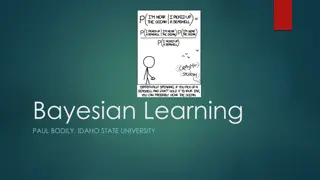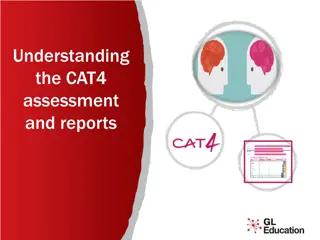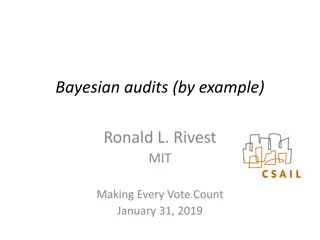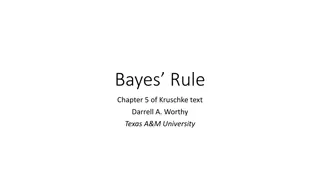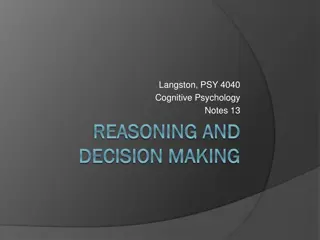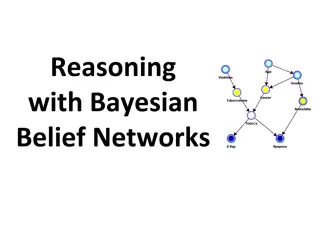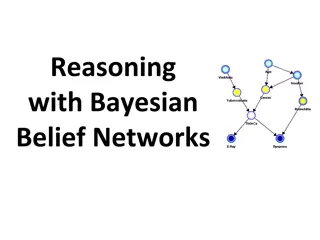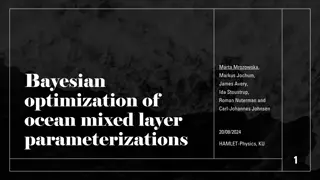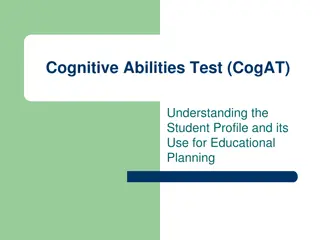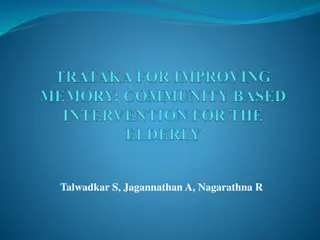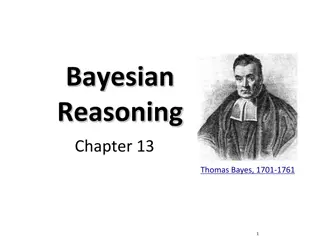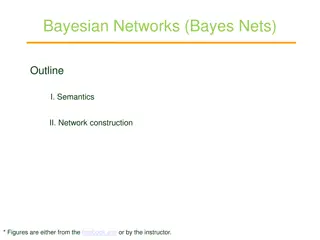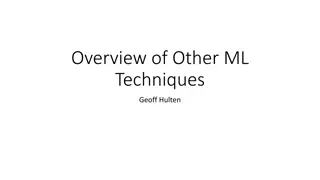Exploring Statistical Learning and Bayesian Reasoning in Cognitive Science
Delve into the fascinating realms of statistical learning and Bayesian reasoning in the context of cognitive science. Uncover the intricacies of neural networks, one-shot generalization puzzles, and the fusion of Bayesian cognitive models with machine learning. Discover how these concepts shed light on human-like learning processes and challenges faced in artificial intelligence.
Download Presentation

Please find below an Image/Link to download the presentation.
The content on the website is provided AS IS for your information and personal use only. It may not be sold, licensed, or shared on other websites without obtaining consent from the author. Download presentation by click this link. If you encounter any issues during the download, it is possible that the publisher has removed the file from their server.
E N D
Presentation Transcript
Statistical learning http://compcogscisydney.org/psyc3211/ A/Prof Danielle Navarro d.navarro@unsw.edu.au compcogscisydney.org
Where are we? L1: Connectionism L2: Statistical learning L3: Semantic networks L4: Wisdom of crowds L5: Cultural transmission L6: Summary
Why do networks get this wrong? A goat being held by a child is labelled a dog Goats in trees become birds or giraffes http://aiweirdness.com/post/171451900302/do-neural-nets-dream-of-electric-sheep
Why do networks get this wrong? Lake, B. M., Ullman, T. D., Tenenbaum, J. B., & Gershman, S. J. (2017). Building machines that learn and think like people.Behavioral and Brain Sciences, 40.
Learning slow Each epoch is about 150 trials This learning unfolds over 750,000 episodes
Learning fast Here is a letter written in an alien alphabet Please write down nine more examples
A Turing test: Which is the human and which is the machine? The puzzle: How does a human (or machine) do this one-shot generalization if learning is slow???
Structure of the lecture What is Bayesian reasoning? Two examples of psychological models Coincidence detection Perceptual magnet effect Linking Bayesian cognitive models with Bayesian machine learning
P(d|h) : the likelihood of observing d if h is true P(h) : the prior probability that h is true P(h|d) : the posterior probability that h is true P(d) : the probability of the data But what does this any of this gibberish mean?????
What happened here? An example of Bayesian reasoning
There are many possible explanations dropped a wine glass broke a window psychic explosion a wizard did it earthquake
Lets consider two of them Someone dropped a wine glass Kids broke the window
Prior beliefs P(h) is the prior, and refers to the inherent plausibility of h as an explanation, before observing any evidence = 1/10 Before learning anything else I think wine glass dropping is 10 times more plausible than broken window Relative plausibility of two hypotheses is the ratio between their prior probabilities, the prior odds
Some data d = there is a cricket ball next to the broken glass
Likelihood of the data P(d|h) is the likelihood, and describes the probability that we would have observed data d if the hypothesis h were true When I drop a wine glass It s very unlikely that I just happen to do so right next to a cricket ball P(d|h) = 0.001
Likelihood of the data P(d|h) is the likelihood, and describes the probability that we would have observed data d if the hypothesis h were true When the kids break a window It s not at all uncommon for a cricket ball to end up near the glass P(d|h) = 0.15
Likelihood of the data P(d|h) is the likelihood, and describes the probability that we would have observed data d if the hypothesis h were true 0.15 = = 150 0.001 The data (cricket ball) are 150 times more likely under the broken window hypothesis Relative probability of the data according to the hypotheses is the evidentiary value of the data, referred to as the likelihood ratio (or the Bayes factor)
Posterior beliefs P(h|d) is the posterior, and refers to the updated plausibility of h as an explanation, after observing the evidence Posterior odds = 15 Prior odds = .1 Likelihood ratio = 150 In light of the evidence, I now think that window-breaking is 15 times more plausible than dropped-wine-glass
Prior probabilities for all hypotheses 0.01 0.01 0.01 We have a set of hypotheses h, (called a hypothesis space) each of which has some degree of prior plausibility 0.80 0.08 There is a conservation of beliefrule if we listed all the hypotheses and assessed their prior plausibility, they would have to sum to 1
Likelihoods for the data, according to each hypothesis 0.5 0.03 0.001 Every hypothesis supplies a likelihood the probability of the data (cricket ball) if that hypothesis is correct
Prior x Likelihood To calculate posterior plausibility, hypotheses are scored by multiplying the prior plausibility by the likelihood of the data My posterior belief P(h|d) in h now that I ve seen data d the prior belief P(h) multiplied by the likelihood P(d|h) is proportional to (we ll come back to that)
Prior x Likelihood To calculate posterior plausibility, hypotheses are scored by multiplying the prior plausibility by the likelihood of the data The posterior must satisfy the conservation of belief, and must sum to 1 The prior must satisfy the conservation of belief, and must sum to 1
Bayes rule Conservation of belief means that we have to divide by the sum, taken over all hypotheses
Bayes rule That big sum is referred to as the probability of the data P(d) (still confused? the tutorial exercise will go through this!)
Bayesian models of cognition Example1: When is a coincidence more than a coincidence?
Mere coincidence? Or something else? You are travelling overseas and meet your next door neighbor You flip a coin 10 times and it comes up heads every time A stage magician flips a coin10 times and it comes up heads every time Five people are having a conversation and they were all born on a Monday
Coincidences model (Griffiths & Tenenbaum 2007) Argues that we evaluate two hypotheses: h1: the observations are due to chance outcomes from an unstructured process h2: the observations are the product of a structured process
Coincidences model (Griffiths & Tenenbaum 2007) (logarithm of) the posterior odds (logarithm of) the prior odds
Coincidences in space When is spatial clustering mere coincidence ?
Coincidences in space Increasing the total number of points . Human Model Human Model Changing the proportion of points
Coincidences in space Human Moving the points around Model Changing the spread Human Model
But its complicated (Tauber et al 2017) A group of scientists investigating genetic engineering have conducted a series of experiments testing drugs that influence the development of rat fetuses. All of these drugs are supposed to affect the sex chromosome: they are intended to affect whether rats are born male or female. The scientists tested this claim by producing 100 baby rats from mothers treated with the drugs. Under normal circumstances, male and female rats are equally likely to be born. The results of these experiments are shown below: The identities of the drugs are concealed with numbers, but you are given the number of times male or female rats were produced by mothers treated with each drug.
But its complicated (Tauber et al 2017) Empirical data for individual subjects are systematically flatter we revise our beliefs more slowly when evidence arrives If people used the optimal statistical model to update data curves should look like this (very old phenomenon conservatism in belief updating)
But its complicated (Tauber et al 2017) People do have stronger prior biases to believe that a genetic experiment works (as opposed to psychokinesis ) but we also apply a more conservative Bayesian belief revision rule when the data are at odds with our priors!
Bayesian models of cognition Example 2: How do categories influence perception?
Bayesian perceptual magnets (Feldman et al 2009) We have knowledge about the perceptual categories that are used in our language Sensory input is noisy, and it s often hard to decode speech sounds
Bayesian perceptual magnets (Feldman et al 2009) Blah blah blah lots of fancy maths because they are smart Short version: Knowledge about the perceptual/linguistic categories supplies a prior P(h) for what the possible speech sound could have been Sensory system supplies the likelihood P(d|h) that we would receive this input given any speech sound
Bayesian perceptual magnets (Feldman et al 2009) The categorical knowledge shapes the perceived sound The predicted distortion pattern depends on the locations of the categories
Bayesian perceptual magnets (Feldman et al 2009) Example 1: Moving the stimulus relative to the category
Bayesian perceptual magnets (Feldman et al 2009) Example 2: Changing the strength of prior knowledge relative to the noise in the environment
Bayesian perceptual magnets (Feldman et al 2009) The perceptual magnet effect is strongest in moderately noisy environments, roughly in accordance with model predictions (Needs to be clean enough that you can work out what the category is supposed to be but not so noisy that you can t hear anything)
Connecting Bayesian cognitive models with Bayesian machine learning
The structure problem A goat being held by a child is labelled a dog Goats in trees become birds or giraffes
The structure problem Even though it is comparatively simple, this is still a structured object. It has distinct parts, they are related to one another There is a production method (writing) that tells you what the relations are Human reasoning about these concepts exploits this knowledge How do we build theories that do that?
Human level concept learning with Bayesian program induction (Lake et al 2015)




